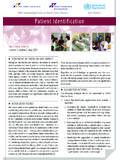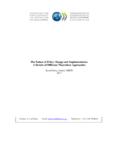Transcription of An Analytical Solution to Reasonable Royalty …
1 -0- An Analytical Solution to Reasonable Royalty Rate Calculationsa William Choib Roy Weinsteinc July 2000 Abstract The courts are increasingly encouraging use of more rigorous, scientific approaches to Royalty rate calculations. The technique proposed in this study applies a classic, peer-reviewed game theoretic model that yields an efficient and fair result. The model can be used to supplement the Georgia-Pacific template for a Reasonable Royalty rate calculation. This should allow patent infringement litigation to build on Georgia-Pacific by interpreting evidence and data in ways that reflect economic conditions governing the outcome of a hypothetical negotiation. a This paper reflects the opinions of the authors and not those of InteCap, Inc. The concepts and theories covered by this presentation are not intended to be all-inclusive on the topic of Reasonable royalties.
2 The concepts are for illustrative purposes and may not represent approaches that the authors or InteCap would recommend in a particular matter. The reader should keep in mind that each case should be evaluated in light of its own facts and circumstances. b , 1993 University of California-Riverside; , 1999 Duke University. William Choi is a Director at Micronomics, Inc., an InteCap company, located in Los Angeles. c , 1964 City College New York; , 1967 University of Chicago. Roy Weinstein is a Managing Director at Micronomics, Inc., an InteCap company, located in Los Angeles. -1- I. Introduction The determination of a Reasonable Royalty rate to be found in a licensing agreement that doesn t exist and never existed is a formidable assignment for licensing experts and triers of fact. Since 1970, Georgia-Pacific v. Plywood has served as the conventional template for calculating such Royalty rates. Georgia-Pacific sets forth fifteen factors to be considered in the context of a hypothetical negotiation between a willing licensee and a willing licensor at the time of the infringement.
3 The Georgia-Pacific template has been criticized on grounds that use of these factors can produce a Royalty rate unsupported by economic theory: licensing experts run down the list and identify some factors in support of high rather than low Royalty rates, while other factors are thought to point in the opposite direction. What can result is an unsound calculation shrouded by reliance on Georgia-Pacific. In fact, courts appear to tire of attempting to apply these factors as a group, often finding them unhelpful. As Judge Glasser noted in Gasser Chair Company, Inc. v. Infanti Chair Manufacturing , It would be an affectation of research to cite the countless cases which simply reiterate the Georgia-Pacific factors to be considered in determining a Reasonable set out those fifteen factors would also needlessly burden this decision The testimony of licensing experts can be strengthened by consideration of economic theory, rather than solely the identification of which factors in the Georgia- 1 Georgia-Pacific Corp v.
4 Plywood Corp., 318 F. Supp. 1116, 1121 ( 1970), modified, 446 F. 2d 295 (2d Cir. 1971), cert. denied, 404 870, 92 S. Ct. 105, 30 L. Ed. 2d 114 (1971). 2 Gasser Chair Company, Inc. v. Infanti Chair Manufacturing Corp., 943 F. Supp. 201 (1996). -2- Pacific list support high rather than low Royalty rates. We are not suggesting that the Georgia-Pacific factors be abandoned; they provide a good reference and starting point. Instead, we suggest that licensing experts also focus on two economic concepts that often are central: (1) anticipated profitability of the technology and (2) relative bargaining power of the participants. While the other Georgia-Pacific factors need not be ignored, these two areas should be closely examined when data permit. Our attempt to narrow the focus on profitability and relative bargaining position is not novel to the discussion of Reasonable Royalty calculations.
5 In Honeywell v. Minolta,3 Judge Wolin replaced Georgia-Pacific factor number twelve with the anticipated profits and losses that the parties reasonably anticipated as a consequence of consummating a licensing agreement. Judge Wolin also cited relative bargaining position as an important factor. Furthermore, the first two Georgia-Pacific factors relating to established royalties and other comparable agreements were omitted from the Honeywell analysis. These additions in Honeywell have been described as helpful to licensing experts in the determination of commercially realistic We suggest that the two-person bargaining game as described by John Nash5 accommodates the need for a clear and precise methodology that relies exclusively on anticipated profitability and relative bargaining power in the calculation of a Reasonable Royalty . The Nash Bargaining Solution ( NBS ) has been called the most fundamental model in bargaining theory, which looks for a sharp prediction of the bargaining outcome 3 Honeywell v.
6 Minolta, Civil Nos. 87-4847, 88-1624 ( 1992). 4 Robert Goldscheider, The Employment of Licensing Expertise in the Arena of Intellectual Property Litigation, 36 IDEA: The Journal of Law and Technology 159 (1996), 5 John Nash, The Bargaining Problem, 18 Econometrica 155 (1950); John Nash, Two-Person Cooperative Games, 21 Econometrica 128 (1953). -3- based on the bargaining strengths of each side. The NBS is well supported by economic theory and is regarded as one of the simplest yet most fruitful paradigms in game The Analytical clarity of the NBS also is an important justification for its use as another useful tool in calculating a Reasonable Royalty . II. Nash Bargaining Solution Nash obtained his Solution by developing a set of Reasonable conditions, or axioms, that any plausible Solution must satisfy. These are as follows: 1. Pareto efficiency; that is, there should be no other feasible allocation that is (a) better than the Solution for one negotiator and (b) not worse than the Solution for the other negotiator.
7 2. Negotiators must collectively behave in a rational manner such that neither side gets less in the bargaining Solution than could be obtained in disagreement. 3. The Solution is independent of any numeric specification;7 that is, if we change the way we measure the payoffs when we construct a two-person bargaining problem, then the Solution corresponds to the same 4. Eliminating alternatives other than the disagreement profits (opportunity costs from licensing) that would not have been chosen should not affect the Solution . 6 Alvin Roth, Axiomatic Models of Bargaining (1979); Abhinay Muthoo, Bargaining Theory with Applications (1999). 7 More formally, the Solution is independent of any numeric risk-neutral utility specification. 8 But keeping the numeric scales equivalent to the original ones -4- 5.
8 If the disagreement profits of the two parties are equal in the bargaining problem, then the Solution also should treat them equally. Using an ingenious mathematical argument, Nash demonstrated that satisfying these conditions defines a unique Solution where the bargaining outcome simply rests on each negotiator s back-up alternative and the potential benefits of cooperation. That is, the NBS requires only knowledge or estimation of (1) the disagreement profits of both the licensee and licensor and (2) the total profits from a licensing agreement. Once these elements are determined, the NBS yields a unique and efficient compromise. To solve for the NBS, we must first identify the disagreement profits for the patent holder, the disagreement profits for the infringer/licensee, and the total profit from licensing. We define 1d as the disagreement payoff for the patent holder, which represents the profit the patent holder expects to receive if the negotiation fails.
9 Likewise, we define 2d as the disagreement payoff for the infringer. The exact functional form of these disagreement payoffs depends on specific assumptions about the two firms and economic conditions. The feasible payoff from licensing is represented by , which is the total profit from licensing. We also define the variables 1 and 2 as profit for the patent holder and infringer/licensee, respectively, from licensing. Nash demonstrated that the only point that satisfies the conditions outlined above is the one obtained by solving the following constrained maximization problem: ()()2211,21maxdd (1) subject to the following conditions: 11d (2) 22d (3) -5- +21 . (4) When transfer payments are permitted between the two agents, the bargaining problem can be fully characterized by three factors: (1) the disagreement payoff for the patent holder; (2) the disagreement payoff for the infringer/licensee; and (3) the total transferable wealth available to the two firms from Thus, the conditions for the equilibrium payoffs are: 2*21*1dd = , (5) =+*2*1 , (6) where *i is the equilibrium payoff for firm i.
10 Solving equations (5) and (6) yields the NBS: ()211*121ddd += , (7) ()212*221ddd += , (8) =+*2*1 . (9) Equations (7) and (8) have the following interpretation: the entities bargain over the partition of total profits ( ); they first agree to give each other the payment that they respectively would obtain from not reaching agreement; then, they split the remaining profits equally. For each firm, the agreement payoff is greater when its own disagreement point is higher and its opponent s disagreement point is lower. Therefore, the relative bargaining power will depend on each side s respective outside opportunities. 9 Roger Myerson, Game Theory: Analysis of Conflict (1991). Transfer payment is an important assumption that can guarantee the given scale factors in a game will also be the natural scale factors for the NBS. Risk neutrality is also an important assumption when -6- The fundamental insight of the NBS is that the alternatives to agreement that are available to each side limit how good a bargain the other partner can obtain.









